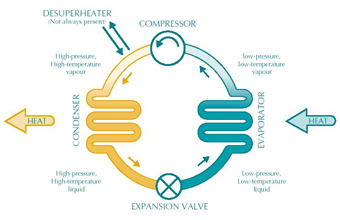You already have a heat pump in your home – your refrigerator. If you put your hand behind it, you’ll feel the heat that’s being pumped from the inside. How It Works: Anatomy of a Heat Pump. It’s the same principle that a geothermal heat pump uses to warm your home.
Instead of producing heat like a conventional furnace, a geothermal heat pump moves heat from one place to another – from the ground into your home
Summer cooling process
The diagram below illustrates the summer cooling process:
The cool, liquid refrigerant enters the indoor coil during cooling. As it enters the coil, the temperature of the refrigerant is between 40 and 50 degrees. Anatomy of a Heat Pump.As warm, moist room air passes over the cool coil, the refrigerant inside absorbs the heat.The new cooler, drier air is circulated back into the room with a blower fan.The refrigerant moves into the compressor, which is a pump that raises the pressure so it will move through the system. The increased pressure from the compressor causes the refrigerant to heat to roughly 120 to 140 degrees.The hot vapor now moves into contact with the condenser (the underground loops), where the refrigerant gives up its heat to the cooler ground loop, then condenses back into a liquid.As the refrigerant leaves the compressor, it’s still under high pressure. It reaches the expansion valve, where the pressure is reduced.The cycle is complete as the cool, liquid refrigerant re-enters the evaporator to pick up room heat.Winter heating process
During the winter, the reversing valve switches the indoor coil to function as the condenser, and the underground piping to act as the evaporator. In short, the indoor coil and underground piping cause the refrigerant to change state, absorbing and releasing heat through boiling and condensing. The compressor and expansion valve move the refrigerant through the system by changing the pressure.




